Kedreeva, She/They, Ace, 39. If you need someone to talk to, you've found me. You've found shelter where I keep vigil for those who need a solid wing under which to rest. Welcome. This is a personal blog with a lot of fandom stuff.
Don't wanna be here? Send us removal request.
Text
Update, she has turned around

I feel you should also know that this laundry basket is not on the ground.

She's been on this nest ALL DAY. Which is fine, she can be broody if she wants. The problem is that broody hens get off the nest once a day to do a big nasty broody poop, eat, drink, stretch, maybe dust bath. And I can't leave the house with her just.... loose. Thankfully I've got nothing on this week for once, and more than enough food and drink, so she's welcome to sit there.
Unfortunately,

She didn't poop at all today until I made her get up and walk around, and then I had to clean up This. Stinky. For size reference, her foot in the back there is ~5 inches long.

I set up a laundry basket with Bug's nesting material and she was okay with me putting the stand down and then putting the laundry basket in and then putting the padding in and then putting the cardboard in to simulate ground, and then I got to the quilt and the light came on and she realized that I was touching her nest and she just started biting me and biting me and biting me. So then I had to finish her nest while fending her off, but I did it. And once it was finished and I put her dummy eggs in (not hers, just eggs from Eris' pen that are empty) and she climbed in and laid on them. Furious with me for keeping her from her nest.

Head empty
360 notes
·
View notes
Text


#cavatappi all the way#the sauce can go inside AND outside#it's like the baby of rotini and elbows#it's one of my top 3 pastas#rontini is Bug's favorite pasta tho so I usually have that on hand#I came to this blog specifically to find this poll#because I love cavatappi#polls
115 notes
·
View notes
Text


#it's shells#bowties always stay gummy in the middle and it's not good#I mean they have some use probably#and they're better than linguini that's for sure#but c'mon#velveeta shells and cheese? YUM#polls
351 notes
·
View notes
Text
@luckyspike is being mean to me

Bug has been on her new nest ALL DAY. She stood up to lay an egg around 4:30pm (really early for her, usually she lays around 8pm), and I gave her a bowl of food (mice, grapes, mac and cheese) and water a few times.
86 notes
·
View notes
Text
Bug has been on her new nest ALL DAY. She stood up to lay an egg around 4:30pm (really early for her, usually she lays around 8pm), and I gave her a bowl of food (mice, grapes, mac and cheese) and water a few times.
#bug the peahen#I am so. something.#REALLY CHILD#Aris has a nest due in like... 3-4 days#and it has the most eggs out of any nest except Wendy's#so... maybe I will give Bug one of the blue babies#or wait until Eris' nest hatches a week from now and give her a purple in case I want to keep it#but I'm not sure I trust her not to try to eat it
86 notes
·
View notes
Text
it has been like at least eight years and sometimes I still think to myself, when I am tired, “but I am le tired… well then take a nap! AND THEN FIRE ZE MISSILES” even though in retrospect that is like one of the most embarrassingly unfunny videos to ever come out of the internet
#My mother just sent me this video the other day#to make sure i had seen it#i also still quote it#albino black sheep#it's a pretty sweet quail. ROUND.#end of the world video#internet history#history
150K notes
·
View notes
Note
What's the general consensus on peafowl inbreeding? Because you've talked a bit on it, and you seemed to imply that it's ideally avoided, but not full on harmful. How does that relate to color and patterns, because it seems like only purple and European violet are related color wise. So are most other patterns/colors a result of inbreeding? Just genuine curiosity
With very, very little exception, EVERY recessive mutation in EVERY animal involves some form of inbreed. Usually a specific kind of inbreeding called backcrossing - where you breed a het offspring back to one of its parents, to create homozygous offspring - or line breeding, sometimes sibling to sibling. Dominant genes don't require it, because they'll show regardless. The only exception to recessive genes acting like this is if you had the same genetic mutation happen the same way twice in completely unrelated animals. Which DOES happen, especially on very simple mutations like dilutes, but not always the same way, and after the mutation is away from the origin, without exceptionally accurate tracking of ALL offspring EVER as descended from the OG het, and without scientific testing there's really no way to differentiate between "this individual mutated this gene FRESH" vs "this individual traces lineage back to the OG bird."
Purple and EV are actually unrelated (are not the same mutation and one did not spring forth from the other as far as we know) but they are alleles (take up the same spot on the same chromosome) and do relatively the same thing (make bird purple and brown colored instead of green and grey).
But all the other colors/patterns in peafowl have been the result of backcrossing offspring to parent birds to get homozygous birds, or pairing siblings together get multiple mutations into one bird. As long as you aren't seeing this produce health issues, it is really not a big deal.
#peafowl#asks#anon asks#peafowl genetics#people buy pairs from me all the time#and I think in like...... 15 years of selling birds#I've been asked maybe 3-4 times if I have 'unrelated pairs'
31 notes
·
View notes
Text
The tension between Europe, Russia and the US is so frustrating right now.
We’ve been told to prepare for war be it hybrid or ground but how big is the danger exactly? It’s not clear if our government knows we are in way more danger than they’re letting on or if it’s more of a better safe than sorry mindset.
The Danish government just made a map showing where all the usable bunkers are in case we’ll need them. I’ve followed their guidelines and have food and water for me and my pets for three days as well as an emergency radio and sun/crank powered power-banks. They also advise us to have a bit of cash at home in case we can’t access our banks but I haven’t done that yet besides the few coins I already keep in my decorative piggy bank.
But yeah, it’s really not clear how much danger we’re actually in. My coworkers didn’t follow any of the guidelines a year ago almost out of spite but even they have stated preparing a bit. So while I understand the Americans are stressed out right now, just know we aren’t doing too hot here in Europe either. 🫡
#I hope that it does not come to that and that y'all are safe and sound until we can get this fixed#politics#news#bad things
2K notes
·
View notes
Text
When I was early on in my transition I got in a Lyft, and the driver was this big country guy. I was a little nervous so I just sat quietly in the back.
After a moment he changed the music on his phone to what sounded like a Hatsune Miku song. Curiosity got the better of me, so I finally spoke up and said “is this Hatsune Miku?”
And he said “Yep. You looked uncomfortable, and I know Transgender women like Hatsune Miku, so I thought it might help.”
I think about that interaction a lot.
82K notes
·
View notes
Text

I set up a laundry basket with Bug's nesting material and she was okay with me putting the stand down and then putting the laundry basket in and then putting the padding in and then putting the cardboard in to simulate ground, and then I got to the quilt and the light came on and she realized that I was touching her nest and she just started biting me and biting me and biting me. So then I had to finish her nest while fending her off, but I did it. And once it was finished and I put her dummy eggs in (not hers, just eggs from Eris' pen that are empty) and she climbed in and laid on them. Furious with me for keeping her from her nest.

Head empty
360 notes
·
View notes
Text
Man, the house next to mine is going up for sale and I have wanted to buy it since I moved in because they literally cut a little weird shaped chunk from the 10 acre parcel my land is on, and I want to make it whole again. But I do not have $300k to do that, so I am going to sit and stew about it.
#personal#Longfeather Lane#who wants to live next to me#you can come lay in the peafowl pens any time you want#I'll help you build your own pen so you can have some
105 notes
·
View notes
Text
Indoor Cats: Leashes
Leashes for the Cat Enrichment Masterpost
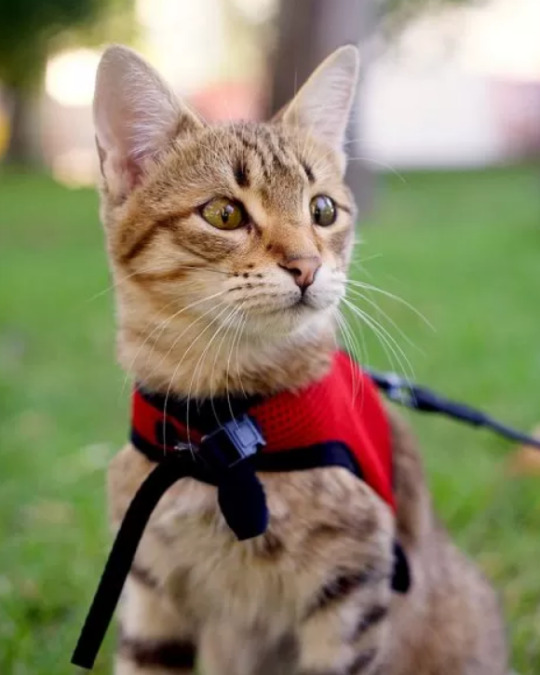
While allowing cats to free roam can be done with supervision, unlike most dogs, cats can be difficult to recall and if they escape beyond an owner’s ability to recover them, the chances of them being found and safely returned are very slim because folks that see a cat out currently assume it’s supposed to be out (another good reason to turn away from unsupervised cats outside… less lost cats that never come home).
Instead, it is becoming increasingly common for owners to train their cats to a harness and leash (or lead) in order to allow them to safely experience some outdoor time, as well as facilitate bonding; cats trained to a harness and leash often learn to associate the items and the person carrying it with the enjoyable experience of going outside.
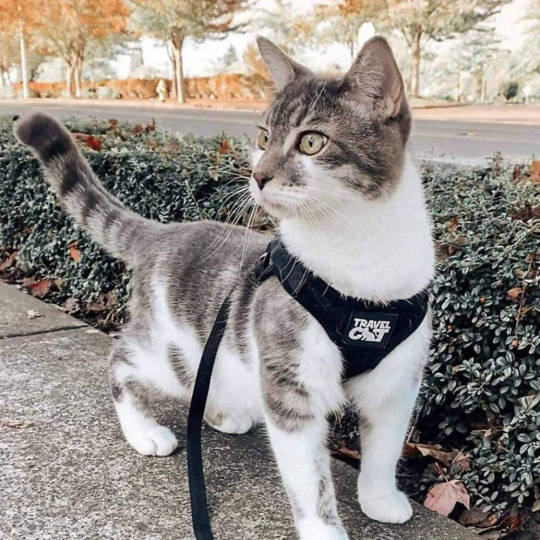
This does not necessarily mean that your cat will enjoy the leash immediately. It takes time for an association to be formed, and repeated exposure and consistency are often the key. Patience is also a virtue in this endeavor, as it is generally recommended to train slowly, by familiarizing them with the harness first and adding the leash later.

There are many good guides out there on how to train your cat to use a leash, but I will direct you first toward adventurecats.org. They are also home to a wealth of articles pertaining to gear choices and taking your cat on an adventure/traveling etc. Chewy also has a guide, as does the cat behaviorist.com. There are also plenty of video guides online that show examples. Do some exploring! Familiarize yourself with the process and the idea behind the process before expecting your cat to go through it.
The other thing to be aware of is that there are DOZENS of types of harnesses. Some cats will take the easiest one and do great. Others are escape artists and require a more secure harness. Because cats have such a huge variance in body type, a harness that comfortably fits one cat may not fit the next one. How the leash attaches and where it pulls comfortably on one cat may not suit another. You may have to do some trial and error to find a leash that works for your cat, so don’t abandon all hope if it doesn’t work immediately on the first try.
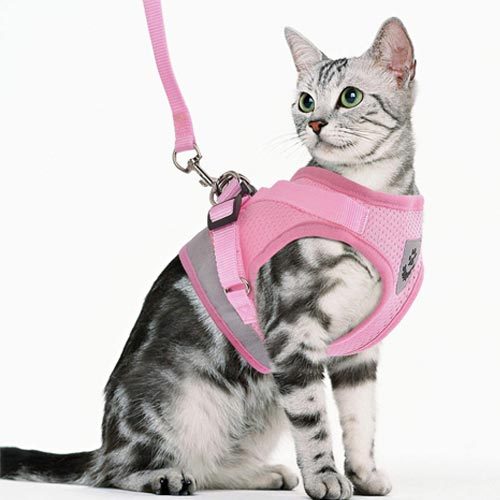
Here’s one made for harness escape artist cats:
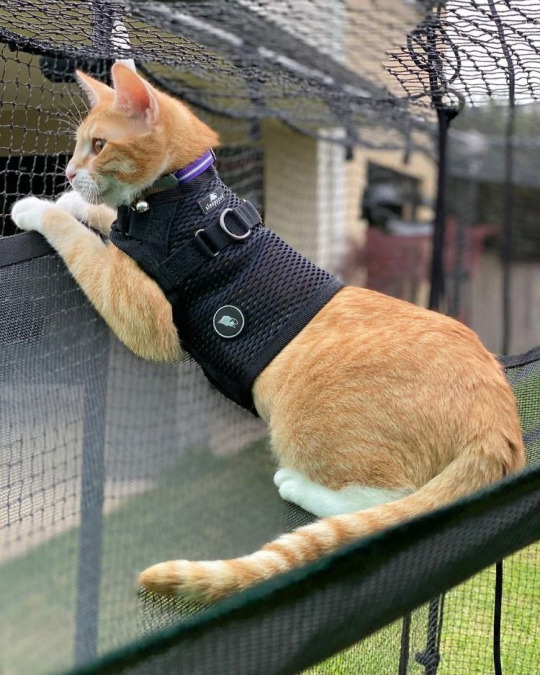
Lead training can also lead to socialization. A lot of folks tend to think of wolves as pack animals and cats as solitary loners, when in fact many cats - including housecats - enjoy being part of a pride or colony. In your home, you become the cat’s family, but while humans spend a lot of time socializing dogs to be friendly to folks outside of their family, cats generally get the short end of the stick because they either don’t leave the house or they leave the house unsupervised and thus have no opportunity to be purposefully exposed to socialization.
A harness and leash can change that, particularly for kittens! Taking your cat out on a leash can help you to take them to various places and maintain control over them the way you would a dog, which can familiarize them with new stimuli and make them overall less prone to stress when there’s a change, as well as help them to be more outgoing toward people because they won’t be as afraid of meeting new ones. It can also make it less scary for things like going to the vet, something a lot of cat owners struggle with because car rides = scary and new places = scary and new people = scary. But that can be way less true if they’re trained early on to use a leash and come visit new places and people while leashed. Now it’s just a new adventure the two of you can share!
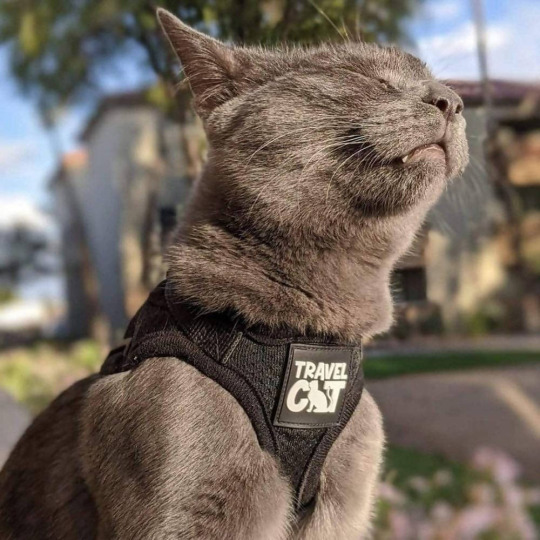
And I have to share one last leash photo, which is technically an accessory to transporting your cat around so you can use your leashes… the cat backpack! They actually have one that, if I understand it correctly, can be reversed around to turn into a cat cave/bed for a nice little hide while camping/adventuring.

Previous: Catios | Next up: Grass Loungers
#gnu peter morwood#cats#indoor cats#erases the background and adds outer space#happy caturday#this showed up in my activity today even though it's years old#and you can't ignore a gnu
5K notes
·
View notes
Note
I know Australian breeders I can ask if your post will do eggs within the country :) I don't have that info but I can point you in their direction.
You mentioned eating peafowl eggs by themselves. What experiences do you have with using them for cooking/baking? How do they differ from chicken eggs (size/taste/texture?)? I have no access to peafowl eggs, I'm just curious if you can use them in cakes and such.
You can, although the size may make a difference in ways you may or may not like, and the texture on the eggs (in my experience) makes things like cake.... I guess I want to say "scratchy" but in the way cornmeal is scratchier than bread flour... but it's a wetter scratchy. Which is PROBABLY the result of being Too Much. An average chicken egg weighs like 40-60g, an average peafowl eggs weighs around 90g. Recipes that are inexact about egg weight/size may not easily account for how much of a peafowl egg you need to use or not use.
#replies#you cannot receive eggs in Australia alas#you guys are missing so many cool mutations because of this#peafowl
55 notes
·
View notes
Note
Quail conformation anon: thank you! That was an incredibly helpful run down. I'm basically just looking to breed for health and temperament, as well as consistency. Good birds that predictably throw more good birds, with a steady laying schedule, uniform eggs, and decent climate hardiness (within reason).
I'm looking to start with regular old coturnix, but there are a ton available around me and I had very little idea where to start looking for ones that do possess the qualities that makes for a healthy bird. A lot of the people around here kind of just chuck them together and don't put much thought into pairings, and then produce wonky or inconsistent birds, which is what I'd like to avoid, but it also means that the majority of the birds I've seen in person have been bred by people who just raise them for meat and don't really put consideration into things like structural soundness beyond the basics of "it can move around? Yes? Perfect" or longer-term health. And I can *tell* that a lot of them don't look quite right but I can't always put my finger on what it is that looks "off" to me because like I said, I have very little knowledge of what they SHOULD look like.
Yeah I see it a lot here too, people not caring at all. And I'm not saying I don't ALSO produce those birds; this year especially, I've set a lot of eggs that I would consider to be "garbage" type eggs (ones that I would not set for myself, because I don't want how that egg texture is, or the color on the CE eggs isn't ideal) because I do frozen day old feeders but I've also gotten a LOT of requests from people who literally say up front that they don't care what kind or don't care about anything but numbers (I assume for meat raising, which fair enough, if I was just going to eat it, pretty much any half-decent bird will do I suppose). I'm always up front about the quality, but some people really do just not care.
You also reminded me: on the point of climate tolerance. Coturnix are not great at being in extreme heat, but they're generally great at being in colder climates. But you DO have to keep a little bit of an eye on it. I take all of my babies off heat by 2.5 weeks (sometimes as early as 2 weeks), and any that handle that transition poorly get culled out (either by selling them off or hard culling for the freezer). It's pretty rare these days, maybe 1 in every 200 birds or so, but it was a lot more common a couple years back. They should easily be able to tolerate freezing temps at 4 weeks old, so if they can't, then you'll have work to do (unless you live someplace it doesn't really get freezing).
And to temper expectations; even a GOOD line will produce some duds. Even a jumbo line will produce some non-jumbo birds. ANY line that you take birds from and combine with any other line (and I recommend getting lines from a few different areas if you can hatch eggs, just to open up genetic diversity at the start) is going to present selection challenges. It takes time to develop a line that's yours, to whatever your desires for them are, but bar little exception, if you're starting with several sources, you can select nice birds out of even crappy starter birds, it's just a matter of how long you want to be doing the initial selection work (as opposed to the maintenance selection work.... which is basically the same thing except you have more nicer birds)
#asks#anon asks#like obviously look for some good starters#but if you can't find what you want don't give up!#also do NOT be afraid to get something and then decide welp that's not for me#and switch tacks#do not let the sunk cost fallacy get you
34 notes
·
View notes
Text
Wasp-posting-wednesday!!
Ever heard a wasp tantrum before?
She (a great golden digger wasp, sphex ichneumoneus) was trying to dig a hole for her offspring, but the blades of dead grass were getting in her way. So while trying to grip and tear them out, she was buzzing and huffing which made it look as if she was having a tantrum. Pretty funny and cute. Turn up your volume to hear her squeak!
6K notes
·
View notes
Note
What do you look for in your quail, structurally? What makes a major flaw that's an automatic cull (aside from things that are obviously incompatible with life or impair basic daily functions) vs a bird who might have some minor flaws but stays in the breeding flock vs your ideal?
I know a fair bit about horse and dog conformation but very little about the way birds are put together. I'm planning on getting quail sometime in the not-too-distant future and whilst I've done my research re: daily care (thank you for posting all you do about them! I've learned a lot from you and it's made me feel a lot more capable of sorting out quality information from poor information as I've been reading care guides, blogs, etc) I want to know more about what makes for a quality bird so I can ensure that when I do eventually get a male I'm breeding towards quality and not putting out more substandard BYB birds.
So, there's not really a "standard of perfection" for coturnix the way there are for, say, horses, or chickens, or dogs. They're a game bird. Right now as it stands, the only 'standard' officially for game birds is "if they are alive, they are perfect" because the point of a game bird is survival. There IS a group that are attempting to put out a standard of perfection for coturnix, but the club is a) really young, like a year old and b) paywalled. You can't see the SOP at all until you pay a $25 fee and... I'm sorry, but I'm not going to do that.
So, what you turn to in this instance is the wild type.
C. japonica

and on the ground:

and C. coturnix

And on the ground

Pretty much all the "coturnix" quail in the USA are hybrids of these two species (and even possibly others), as they were not kept well separated over the years.
If you want to breed to a standard of perfection for a game bird, then you breed toward its wild type- black beak, Red reds, gradient chest, somewhat slender body, clean markings, the ability to stand well on their legs (some coturnix get really stubby legs), no "roached" back, bigger wings, correct facial markings, etc.
If you just want to breed for HEALTH, then you want a nice smooth back, nice high legs that make it easy for them to walk around, a face that isn't smushed in on itself and also isn't so collapsed down that it becomes thin and needle like. Good feathering on your birds (especially the belly, which can suffer if the bird isn't standing up on its legs like it should). A good temperament (ie, not aggressive, not throwing itself senselessly at walls and stuff if you so much as look their way, etc) is a must for keeping them healthy, because it means the males won't overbreed/injure the hens, the hens won't pick on each other, and the birds won't injure themselves out of fear.
On the chicks, you will want to cull things like clubbed feet, powder down, crossed beaks, wry neck... pretty much anything that isn't a vigorous, healthy chick. You do NOT want to assist hatch eggs; the only except may be if you open the incubator and you see a current pip, and come back and it hasn't zipped in a few hours, as you may have caused that problem. But, assist hatching just creates weaker individuals. Personally i don't keep late-hatch birds for breeding (nothing over 18 days, and most of mine hatch at 16-17, so even 18 is pushing it for me), and I don't keep late-to-lay hens if I can help it (if they aren't laying by 12 weeks, they go, as they should be starting to lay by about 10 weeks).
On eggs, you typically don't want to hatch anything under 14g. That said, if you're starting with standards, none of your eggs will be that size. In that case, check the average weight of your eggs to determine a median weight, and then say okay, nothing below the median gets hatched. Re-assess when you find yourself able to set the majority of your eggs, to find the new median, until the majority of your eggs are over 14g. Anything above 20g has a fairly high possibility of being double yolked. You also want to keep up with egg shell quality; test strength by giving a relatively gentle squeeze between your pointer and thumb (over a sink or big bowl). A normal egg will be able to withstand a pretty good deal of pressure. Shells should be relatively bright, smooth, and shiny, not matte, not bumpy, not pale (heavy bloom, not enough protoporphyrin), not dark (too much protoporphyrin affects hatch rate). Egg shape should be fairly uniform, with a clear wide side and narrow side, without being misshapen (elongated, squashed, rippled, etc).
I hope that at least gets you started!
68 notes
·
View notes
Note
You mentioned eating peafowl eggs by themselves. What experiences do you have with using them for cooking/baking? How do they differ from chicken eggs (size/taste/texture?)? I have no access to peafowl eggs, I'm just curious if you can use them in cakes and such.
You can, although the size may make a difference in ways you may or may not like, and the texture on the eggs (in my experience) makes things like cake.... I guess I want to say "scratchy" but in the way cornmeal is scratchier than bread flour... but it's a wetter scratchy. Which is PROBABLY the result of being Too Much. An average chicken egg weighs like 40-60g, an average peafowl eggs weighs around 90g. Recipes that are inexact about egg weight/size may not easily account for how much of a peafowl egg you need to use or not use.
#I did not enjoy adding them to cake#they would probably be good in banana bread#peafowl eggs#eggs#asks#I could always send you an egg to try it if you want to know
55 notes
·
View notes